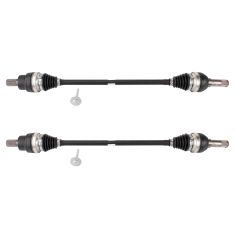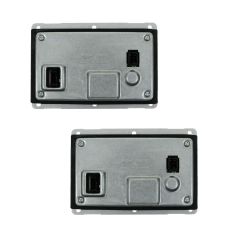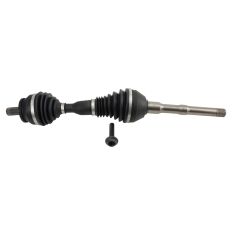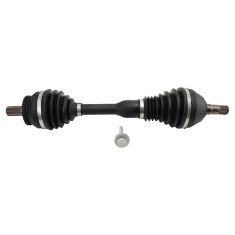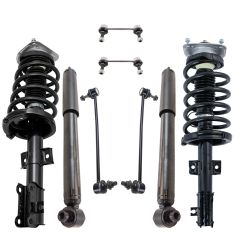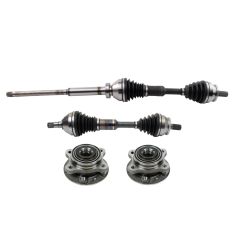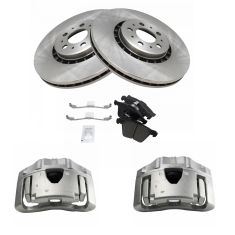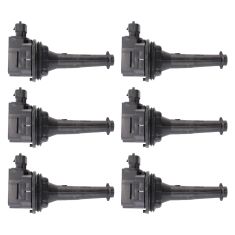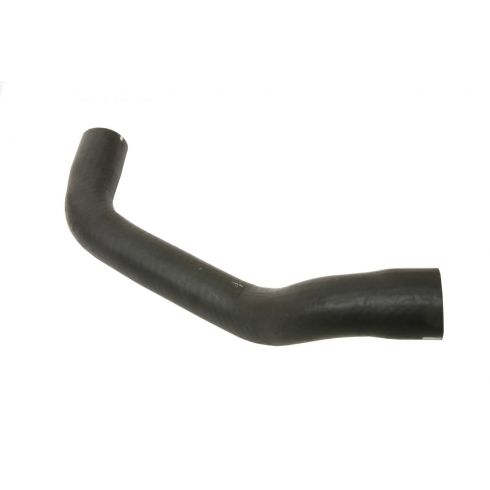Hey friends, it's Len from 1A Auto. Today, we're working on our 2004 Volvo XC 90. This is the all wheel drive version. I'm going to be replacing the upper radiator hose. It'll be super easy. I can do it. You can do it, too. If you need this or any other part. You can always check us out 1aauto.Com. Thanks.
Okay, so now what we're going to do now, that the hood's up, we're just going to open up this right here. This is your coolant reservoir. You want to make sure that your cooling is not hot. This vehicle has been sitting for a while, so I'm not worried about it. We'll set the cap aside and we can move along.
Okay, so now that we're underneath the vehicle, what we're going to do is we're going to try and get this out of here so we can get to the radiator that's located right here. It'll be very easy. We're going to use a 14mm. We're going to take out this bolt, this bolt, there's one hiding up in here, and then the same thing for the other side of the vehicle. All 14s. Got my airgun, 14mm. You can use a ratchet if you want.
Here's what my bolts look like. There's two long ones and then the other four look the same. The two long ones were of course the two that were hiding. We'll set this stuff aside. We can move along to the next step.
Okay, so I grabbed a rubber mallet just in case I need it because what we need to do, these arms right here, they kind of have like a almost like this that goes right up here. Okay? What we need to do is get this to go forward and then come undone and then come out. I'm just getting use my rubber mallet.
Let's give it a couple bonks. Try to lift up. Okay. Just getting it to moves is the hard part here because of the way that these hooks are. There it is. Okay. Almost. Come on, baby. There we are. We got this out of here. Let's move ahead to the next step.
Okay, so we've got our recycling receptacle here. It's ready to catch the coolant that's going to come out. Now what we need to do is drain the coolant. We're going to come right up here, get a little petcock area. We're going to turn this counter-clockwise, that's to the left, with our 13mm socket, and we should have coolant get ready to come out of this. Get in close here. Probably going to make mess. Safety glasses, hand protection. Here we go. Cool. We'll just let this do its thing and we'll move along.
Now, we're going to take the clamp off of the upper radiator hose to the radiator. To do that, I'm going to use a 7mm socket and my quarter inch ratchet. If you think you can do it with a screwdriver, you can also try with a flat head screwdriver. With these clamps, you don't have to loosen them up all the way to the point that they come apart, you just loosen them up enough so you can slide them up the hose a little bit and you can get the hose off of the radiator. It feels pretty loose.
Let's grab the hose, give it a wiggle. Here we are. There's our clamp. This one looks like it's reusable. If you don't think it is, then you'd want to replace it. This one looks decent. I'll set it aside. On to the next step.
Okay, so down at the other side of the hose, we have another clamp. Volvo was nice and they put it so the power steering pump's in the way of taking off the clamp. We're going to try to be sneaky, use our 7mm wrench, and see if we can get it off without having to take off the power steering pump. If we can't, well, then we'll deal with that when we get to it. But for now, 7mm wrench one little turn at a time.
Okay, so I've got that clamp loosened up. We might need to go a little further, but I'm just going to test it. I'm going to use my pry bar here, just see if I can get this hose to break free. You can try to wiggle it, twist it, do whatever you need to do to make it so it comes off. There's our upper hose.
Okay. Friends, a quick product comparison for you. Right here, we have our upper radiator hose out of our 2004 Volvo XC90 all wheel drive version, and right here, we have our brand new quality one, 1A Auto part. Both of these hoses are shaped the exact same. You can hold them like this. They've got all the same bends, which is very important. You want to make sure that you can get around all this stuff you need to get around inside the vehicle in the engine compartment there. You get that end, this end right here. Like I said, exact same. With that said, I don't see any reason why this wouldn't be a quality part to install into the vehicle, so I'm going to go ahead and do it. If you need this or any other part, you can always check us out 1AAuto.Com. Thanks.
Okay, we're going to take our hose. We've got the part with the semi sharp bend, that's going to go on the engine side, the side that just kind of comes out straight with a little woo-hoo. That's going to go on the radiator side. Okay? We'll get this down kind of close to where it's going to go on the radiator. We'll get it down onto the engine side there. I should have mentioned that you want to have your clamp ready. Now when you're putting this back on where this is a new hose, you can set it wherever you want to put it, so whatever's easiest for you to be able to tighten this back up. We'll probably make it nice and easy for the next person to go ahead and loosen it back up. I'm going to go right here. It's not close to this hose, it's not touching in any way, and I just feel like that's going to be much easier for me to get the wrench on and be able to tighten up over time here.
There really isn't any real good angles on this where you'd be able to get a ratchet on there, so it just kind of is what it is. We'll just check, make sure that it's straight. If you've got the end of your hose right here, you don't want your clamp going like this on the hose, right? You want it to be straight cockeyed. Just check it. If it looks good, go ahead and snug it right up.
Once you feel like it's starting to get snug, let's see how much further we got here. It kind of feels it kind of get got a little snug there, so I'm just going to go teeny bit more. That feels really good, just about as much as I can push with just that finger without flexing it too much. Because these clamps right here, they strip out fairly easily, so if you're ever tightening and you come to realize that it's going nice and snug, nice and snug, super snug, loose, you stripped it. In that case, take it off, recycle it, get yourself another one. All right, so there's that side. We'll move ahead to this side.
Okay, so we're going to grab our hose. Grab our hose clamp. We want to take a look and see which way is going to be the best way to put this clamp so when we get the hose on there, we'll be able to tighten it up. There's lots of different ways you can put it. Some of them are going to be worse than the original way Volvo had them on there, so I'll probably just put it just like this and I'll see if I can get my ratchet in there. I just want to put this under here. Get this on there just like that. I'm just going to put it right up onto the hose. Put my hose onto the radiator. It should just work its way on. I like to wiggle it. Here we are. Just take a look. I need a light.
All right. It looks like it's all the way on all the way around the neck of the radiator there. That's super important. You want to make sure that it's all the way on. We'll get our clamp, bring it on over. All right. Once you get it so it's getting pretty snug and it's not wobbling around crazy, you just want to make sure that you have it parallel to the end of the hose. That looks pretty great. We'll continue to snugging it up with our 7mm. Okay. It's bottomed out. Just give it a teeny bit more. Tight. A little wiggle. That feels great. Awesome.
Just putting a little bit of Copper never seize on there. It's going to help to come off down the line. On the skid plate, you've got these little ptons that come down until we're right in between here. This part right here sits up on the subframe area. Right up here. That pton is going to come up and then sit down into its groove right up along the top up there. So if you're struggling and you're getting it over, but it's just not doing its thing, it's because that thing needs to slide down and right there.
All right, so let's get this up here. I'm going to go at an angle. I'm going to try to do one side at a time. Go under there, up over there. Bring this around up this way. Give that a little push. Bonk. There we are. Those little ptons came right down into the sub frame like what we wanted them to do. All of our bolt holes are lined up. Let's grab some bolts and get it in.
All right, so we've got our bolts. We've got four of these, two of these. These two are the same, they're the same as those two over there. Just get those started in. I'm just going to start all these in. We're not going to tighten anything down until they're all started. I'm going to use a 14 with my extension, just so I can get up in here. Now that they're all started, we'll go ahead and tighten them down. All right. All six are tight. Easy peasy.
Okay, so when we're filling the coolant, generally speaking you'd want to apply a vacuum, add coolant that way, because that'll make it so it draws coin into all the areas inside the cooling system. If you don't have access to a vacuum system to be able to fill the coolant, you're just going to have to slowly top it off. It's going to work its way in. Once it gets up, so it looks like it's full, run the vehicle for a little bit. It's going to draw down. Just keep adding. Make sure you're wearing safety glasses as you're doing it once it gets hot. Anything can happen in there. You're going to want to run it for a little while because it's going to burp out a lot of air through this system. There's the heater core, you've got all your cooling hoses, you've got the inside of the engine, all sorts of areas where this coolant's going to need to go. Easy peasy.
Thanks for watching. Visit 1AAuto.com for quality auto parts shipped to your door, the place for DIY auto repair, and if you enjoyed this video, please click the subscribe button.
